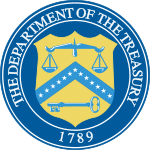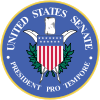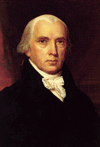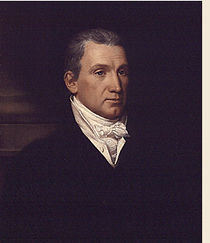William H. Crawford
| William Harris Crawford | |
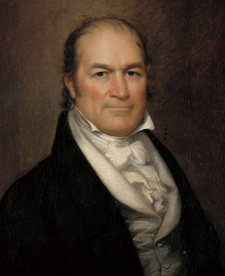 |
|
|
|
|
|---|---|
| In office October 22, 1816 – March 6, 1825 |
|
| President | James Madison (1816-1817) James Monroe (1817-1825) |
| Preceded by | Alexander J. Dallas |
| Succeeded by | Richard Rush |
|
9th United States Secretary of War
|
|
| In office August 1, 1815 – October 22, 1816 |
|
| President | James Madison |
| Preceded by | James Monroe |
| Succeeded by | John C. Calhoun |
|
|
|
| Born | February 24, 1772 Amherst County, Virginia, U.S. |
| Died | September 15, 1834 (aged 62) Crawford, Georgia, U.S. |
| Political party | Democratic-Republican |
| Profession | Lawyer, Politician, Judge, Farmer, Teacher |
William Harris Crawford (February 24, 1772 – September 15, 1834) was an American politician and judge during the early 19th century. He served as United States Secretary of War from 1815 to 1816 and United States Secretary of the Treasury from 1816 to 1825, and was a candidate for President of the United States in 1824.
Contents |
Political career
In 1803, Crawford was elected to the Georgia House of Representatives as a member of the Democratic-Republican Party. In 1807, Crawford joined the 10th United States Congress mid-term as the junior U.S. Senator from Georgia when the Georgia legislature elected him to replace George Jones, an appointee who had held the office for a few months after the death of Abraham Baldwin.
Crawford was elected President pro tempore in 1811. When Vice President George Clinton died on April 20, 1812, Crawford, as President pro tempore, became "Acting Vice President" until March 4, 1813.
In 1813, President James Madison appointed Crawford as the U.S. minister to France during the waning years of the First French Empire; Crawford held that ministerial post until 1815, shortly after the end of the War of 1812.
Upon Crawford's return, Madison appointed him as Secretary of War. After slightly more than a year of satisfactory service in that post (and after disclaiming interest in the 1816 Democratic-Republican nomination for President), Crawford moved within the Cabinet to become Secretary of the Treasury. He remained in that position through the rest of Madison's term and Monroe's entire administration which ended in 1825.
Crawford was again a leading candidate for the Democratic-Republican presidential nomination in 1824. However, Crawford was put out of the running because of a paralytic stroke he suffered in 1823 that was brought on by a prescription given to him by his physician.[1] The Democratic-Republican Party split around this time and one of the splinter groups nominated Crawford. Despite Crawford's improved health (and the support of former presidents Madison and Thomas Jefferson), he finished third in the electoral vote, behind John Quincy Adams and Andrew Jackson. He thus was still in the running when the Presidential election ended up in the House of Representatives, but his stroke made him a non-factor there.
Refusing Adams's request that he remain at the Treasury, Crawford then returned to Georgia, where he was appointed as a state superior court judge. Crawford remained an active judge until his death a decade later.
Societies
During the 1820's, Crawford was a member of the prestigious society, Columbian Institute for the Promotion of Arts and Sciences, who counted among their members former presidents Andrew Jackson and John Quincy Adams and many prominent men of the day, including well-known representatives of the military, government service, medical and other professions.[2]
Personal life
Crawford was born in Amherst County, Virginia, but his family moved south to Appling County, Georgia, when he was a boy. As a young man, he worked as a farmer and a schoolteacher for about 10 years, then began to practice law in Lexington, Georgia, in 1799.
His cousin George W. Crawford served as Secretary of War under President Zachary Taylor.
Crawford was buried in Crawford Cemetery in Crawford, Georgia.

Legacy
The town of Crawfordsville, Indiana, as well as Crawford County, Illinois; Crawford County, Indiana, Crawford County, Iowa; Crawford County, Missouri; Crawford County, Arkansas; Crawford County, Michigan; Crawford County, Wisconsin; Crawfordville, Georgia; Crawford County, Georgia, and Crawford, Georgia are named for Crawford. Crawford is buried in Crawford, Georgia.
In 1875, Crawford appeared on the 50 cent bill.
References
- ↑ They Also Ran, Irving Stone, pg. 36
- ↑ Rathbun, Richard. "The Columbian institute for the promotion of arts and sciences: A Washington Society of 1816-1838.". Bulletin of the United States National Museum, October 18, 1917. http://books.google.com/books?id=MY-5AAAAIAAJ&pg=PA118&lpg=PA118&dq=%22columbian+institute%22&source=bl&ots=norHpKppMQ&sig=Xn1668nfr6y_EhAJVYUcGRBN1pk&hl=en&ei=3jAeTM3mAYHcMaqrjfUM&sa=X&oi=book_result&ct=result&resnum=8&ved=0CCcQ6AEwBzgU#v=onepage&q=%22columbian%20institute%22&f=false. Retrieved 2010-06-20.
Notes
- Garraty, John A. and Mark C. Carnes. American National Biography, vol. 5, "Crawford, William Harris". New York : Oxford University Press, 1999.
External links
- William H. Crawford at the Biographical Directory of the United States Congress
| United States Senate | ||
|---|---|---|
| Preceded by George Jones |
United States Senator (Class 2) from Georgia 1807–1813 Served alongside: John Milledge, Charles Tait |
Succeeded by William B. Bulloch |
| Honorary titles | ||
| Preceded by John Pope |
President pro tempore of the United States Senate March 24, 1812–March 23, 1813 |
Succeeded by Joseph Bradley Varnum |
| Diplomatic posts | ||
| Preceded by Joel Barlow |
U.S. Minister to France 1813–1815 |
Succeeded by Albert Gallatin |
| Political offices | ||
| Preceded by James Monroe |
United States Secretary of War Served under: James Madison 1815–1816 |
Succeeded by John C. Calhoun |
| Preceded by Alexander J. Dallas |
United States Secretary of the Treasury Served under: James Madison, James Monroe 1816–1825 |
Succeeded by Richard Rush |
| Party political offices | ||
| Preceded by James Monroe |
Democratic-Republican Party presidential candidate(1) 1824 (lost) |
Succeeded by End of title |
| Notes and references | ||
| 1. The Democratic-Republican Party split in 1824, fielding four separate candidates: Crawford, John Quincy Adams, Andrew Jackson, and Henry Clay. | ||
|
||||||||||
|
||||||||||||||||
|
|||||||
|
|||||||
|
||||||||||||||
|
||||||||||||||||||||||
|
||||||||||||||||||||||



